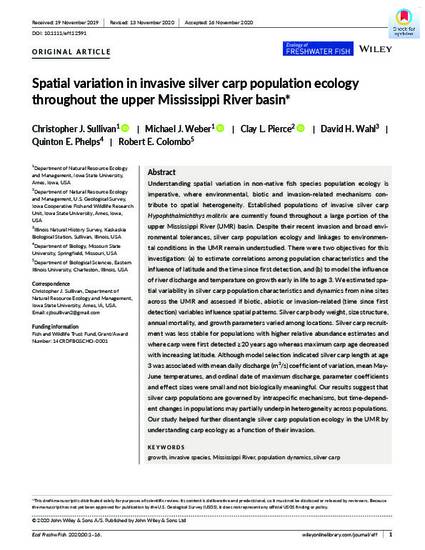
Understanding spatial variation in non‐native fish species population ecology is imperative, where environmental, biotic and invasion‐related mechanisms contribute to spatial heterogeneity. Established populations of invasive silver carp Hypophthalmichthys molitrix are currently found throughout a large portion of the upper Mississippi River (UMR) basin. Despite their recent invasion and broad environmental tolerances, silver carp population ecology and linkages to environmental conditions in the UMR remain understudied. There were two objectives for this investigation: (a) to estimate correlations among population characteristics and the influence of latitude and the time since first detection, and (b) to model the influence of river discharge and temperature on growth early in life to age 3. We estimated spatial variability in silver carp population characteristics and dynamics from nine sites across the UMR and assessed if biotic, abiotic or invasion‐related (time since first detection) variables influence spatial patterns. Silver carp body weight, size structure, annual mortality, and growth parameters varied among locations. Silver carp recruitment was less stable for populations with higher relative abundance estimates and where carp were first detected ≥20 years ago whereas maximum carp age decreased with increasing latitude. Although model selection indicated silver carp length at age 3 was associated with mean daily discharge (m3/s) coefficient of variation, mean May‐June temperatures, and ordinal date of maximum discharge, parameter coefficients and effect sizes were small and not biologically meaningful. Our results suggest that silver carp populations are governed by intraspecific mechanisms, but time‐dependent changes in populations may partially underpin heterogeneity across populations. Our study helped further disentangle silver carp population ecology in the UMR by understanding carp ecology as a function of their invasion.
Available at: http://works.bepress.com/michael_weber/43/

This article is published as Sullivan, Christopher J., Michael J. Weber, Clay L. Pierce, David H. Wahl, Quinton E. Phelps, and Robert E. Colombo. "Spatial variation in invasive silver carp population ecology throughout the upper Mississippi River basin." Ecology of Freshwater Fish (2020). doi: 10.1111/eff.12591.